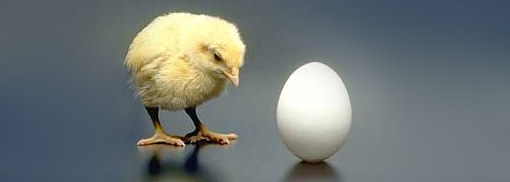What’s First?
Posted on May 23, 2011 | posted by:Note: No animals were harmed during this reflection process.
I recently finished the first phase of research for designing a collaborative system that allows participants the ability to share perspectives of data. As I reflected on the feedback I had received from peers and professors, I realized my strategy of using precedents as a method of communicating my ideas for the system was ineffective. Many were still unsure of what I was doing and while the concept had evolved, I still did not communicate its essence well.
I was stuck in the classic Henry Ford dilemma: How do I communicate that we need a car and not a faster horse? How do I represent something that does not yet exist and is still largely undefined?
Additionally, I was struggling to understand the differences between design-led research and research-led design. Does one lead to another? Are they carried out independently? I re-read Fallman’s paper, Why Research-oriented Design Isn’t Design-oriented Research, in an attempt at gaining a better understanding, while keeping my processes in mind.
As I read, I was drawn to this passage, which sparked the beginning of my understanding of both the types of research discussed and the subject of the research itself:
“In some ways, this resembles the way natural scientists may only be able to test a theory by first designing the tools or instruments with which to study a proposed phenomena [3, 4, 6]. At times, the design of a new instrument also gives rise to new, wholly unexpected discoveries. “
The instrument as a device used by people to explore new possibilities is precisely the desired outcome of the system I was looking to create. Not only the instrument, as a device or tool, but as facilitator of structure and process for collaboration.
The form, content, interconnections and visual language of the narratives people could create with the system I’ve proposed would act as new forms of knowledge, and the system would be this instrument that allows people to create them. I then realized:
This vision, although still hazy, represented my end goal and my work up to that point acted as research for it. In essence, I had conducted various forms of research-led design. So what was design led-research and what were my the next steps? Three key insights formed as I completed Fallman’s paper, along with Houde & Hill’s What do Prototypes Prototype?:
1) The process of prototyping web sites and interaction, of which I relied on heavily in the past, is in essence a form of design-led research.
2) Instead of prototyping an integrated, all-in-one draft of the entire system as I had done before, I could create a variety of prototypes to isolate specific pieces and speculations. Hill categorizes these as role, look and feel and implementation prototypes. Each would provide its own key investigations, particularly by “limiting the necessary actions and therefore controls which needed to be provided”.
3) As Fallman mentions, “exploring possibilities outside of current paradigms; whether these are paradigm of style, technology, or economical boundaries.” This is a central aspect to the desired outcome, and I plan to account for this in my research by creating prototypes that facilitate the discovery of such knowledge.
After digesting these, it became clear of what I needed to do next: narrow and make! I listed some possible leads to prototype :
• Representing narrative timelines and storyboards in three dimensions
• Exploring forms of the individual elements that comprise the narratives
• Experimenting with heterogeneous or homogenous visual representations of information
• Testing the use of metaphors and its context in new forms
• Representing meaning through movement and juxtaposition of individual elements
• Testing dynamics of group size with or without a visual translator/stenographer role
• Testing process structures of collaboration
In addition, new questions formed: Due to fast evolving technology, do I conduct my own research on topics that have a history of research, but in different contexts? At what point does form and context begin to impact the relevance of previous research, and at what point must I abandon previous research and conduct my own?
I gained a fresh perspective of my process and my overall project through this reflection assignment, and I’m looking forward to progressing and challenging myself on the meanings and applications of design and research.
BIBLIOGRAPHY
Fallman, D. (2007) Why Research-oriented Design Isn’t Design-oriented Research: On the Tensions between Design and Research in an Implicit Design Discipline, Journal on Knowledge, Technology and Policy, Special Issue on Design Research, Vol. 20, No. 3, Springer Netherlands.
Stephanie H. & Hill, C. (2004) What do Prototypes Prototype? Apple Computer, Inc. Cupertino, CA, USA
